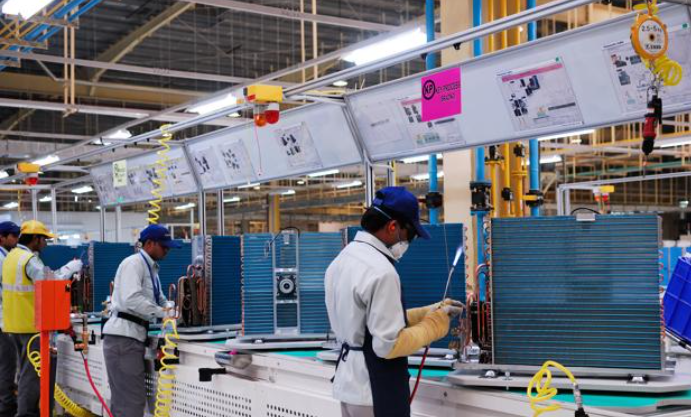In September 2024, Manufacturing Growth India’s manufacturing sector experienced a notable cooling in activity levels, as indicated by the HSBC India Manufacturing Purchasing Managers’ Index (PMI). Factory output and sales growth slowed to their lowest pace of the year, with export orders rising at the most modest rate in 18 months. The seasonally adjusted PMI slipped to 56.5 in September, down from 57.5 in August, reflecting the third consecutive month of decline in manufacturing activity. Although a PMI reading above 50 indicates expansion, this trend points to a broader slowdown in the sector’s growth trajectory.
This article examines the factors contributing to the slowdown in factory activity, the implications for the Indian economy, and the prospects for the manufacturing sector in the near future. By analyzing the PMI data, we gain insights into the challenges faced by manufacturers, particularly in terms of export orders, employment trends, and rising input costs, as well as the broader global economic environment that is impacting India’s industrial landscape.
Overview of the Manufacturing PMI: A Key Indicator of Economic Health
The Purchasing Managers’ Index (PMI) is a widely used indicator to assess the economic health of the manufacturing sector. The index is based on surveys of around 400 companies in various manufacturing industries, covering aspects like new orders, output, employment, supplier delivery times, and inventory levels. A PMI reading above 50 suggests that the manufacturing sector is expanding, while a reading below 50 indicates contraction.
India’s PMI for September 2024, at 56.5, signifies continued expansion in manufacturing activity, but at a slower pace compared to previous months. The decline from 57.5 in August and earlier highs in the year reflects growing concerns over weakened demand, rising input costs, and slowing export orders. This deceleration has raised questions about the sustainability of the sector’s growth in the face of domestic and international economic challenges.
Factors Contributing to the Slowdown in Manufacturing Activity
The cooling of manufacturing activity in India can be attributed to several interconnected factors, both domestic and global. Some of the key drivers of the slowdown include:
1. Weakening Export Demand
One of the most significant contributors to the moderation in manufacturing growth has been the decline in export orders. According to the PMI survey, export orders grew at the slowest pace in 18 months, indicating weakening demand for Indian goods in international markets. This trend is particularly concerning given the reliance of several Indian industries, such as textiles, automotive, and electronics, on export markets.
The global economic environment, characterized by slower growth in advanced economies, rising protectionism, and trade disruptions, has adversely affected demand for Indian exports. Additionally, geopolitical tensions, particularly in Europe and the Middle East, have further dampened global trade prospects, adding to the challenges faced by Indian manufacturers.
2. Slower Domestic Sales Growth
While domestic demand has remained relatively resilient, there has been a noticeable slowdown in sales growth. This is partly due to inflationary pressures that have eroded consumer purchasing power and led to more cautious spending behavior. Rising interest rates, implemented by the Reserve Bank of India (RBI) to control inflation, have also affected borrowing costs for businesses and consumers, contributing to a deceleration in demand.
Sectors such as consumer goods and capital goods, which rely heavily on domestic consumption and investment, have seen a reduction in new orders. The festive season in India, typically a period of heightened consumer activity, has not provided the expected boost to sales, further highlighting the fragility of domestic demand in the current economic environment.
3. Rising Input Costs
Input prices have been rising steadily, putting pressure on manufacturers’ margins. The PMI survey noted that input costs increased at a faster pace in September 2024, driven by higher prices for raw materials such as metals, chemicals, and energy. This rise in input costs has squeezed profit margins, especially for small and medium-sized enterprises (SMEs), which often lack the pricing power to pass on higher costs to customers.
The global supply chain disruptions caused by geopolitical events, such as the conflict in Ukraine and the lingering effects of the COVID-19 pandemic, have contributed to the increase in raw material prices. Additionally, fluctuations in the value of the Indian rupee against major currencies have made imports more expensive, exacerbating the cost pressures on manufacturers.
4. Employment Trends
Despite the slowdown in manufacturing activity, companies continued to hire in September, although at a slower pace. The PMI survey indicated that employment growth had moderated for the third consecutive month, with some firms opting to reduce part-time and temporary workers. Weaker profit growth and rising input costs have likely prompted companies to be more cautious in their hiring decisions, as they seek to manage costs and maintain operational efficiency.
The slowdown in employment growth could have broader implications for the labor market and the overall economy. Manufacturing is a key source of employment in India, and any sustained decline in job creation within the sector could contribute to higher unemployment rates and reduced consumer spending.
Impact of the Slowdown on India’s Economy
The slowdown in manufacturing activity has implications for the broader Indian economy, particularly in terms of industrial growth, employment, and inflation. Manufacturing is a critical component of India’s GDP, accounting for around 15-20% of the total economic output. A sustained slowdown in the sector could weigh on overall economic growth, especially at a time when India is seeking to position itself as a global manufacturing hub under initiatives like “Make in India.”
1. Industrial Growth and GDP
The deceleration in manufacturing growth is likely to have a dampening effect on Manufacturing Growth industrial production, which has been a key driver of GDP growth in recent years. Industrial production data for the third quarter Manufacturing Growth of 2024 is expected to reflect the weakening momentum in the manufacturing sector, potentially leading to a downward revision in growth forecasts for the Indian economy.
The government and policymakers may need to consider additional measures to stimulate Manufacturing Growth industrial activity, such as providing incentives for investment in manufacturing, easing regulatory bottlenecks, and addressing supply chain challenges. A focus on improving infrastructure, reducing logistical costs, and enhancing the ease of doing business could also help support the sector in the medium to long term.
2. Employment and Consumer Spending
The slowdown in employment growth within the manufacturing sector could have a ripple effect on consumer spending, as reduced job creation and wage growth may lead to lower household incomes. Consumer spending is a key driver of economic growth in India, and any sustained weakness in employment trends could affect demand for goods and services across various sectors of the economy.
To mitigate Manufacturing Growth the impact on employment, the government could consider targeted interventions, such as providing support for SMEs, which are significant employers in the manufacturing sector. Additionally, investments in skill development and training programs could help workers transition to new roles in emerging industries, such as green energy and digital technologies.
3. Inflationary Pressures
The Manufacturing Growth rise in input costs, as highlighted by the PMI survey, is likely to contribute to inflationary pressures in the coming months. While factory gate price inflation eased in September, the persistence of high input costs could eventually lead to higher prices for consumers, particularly if manufacturers decide to pass on the increased costs to end-users.
Inflationary pressures are already a concern for the Indian economy, with the RBI maintaining a cautious stance on interest rates to prevent inflation from exceeding the target range. Any further increase in inflation could complicate the central bank’s efforts to balance inflation control with the need to support economic growth.
Global Factors Affecting Indian Manufacturing
The slowdown in Indian manufacturing is not Manufacturing Growth occurring in isolation but is influenced by broader global economic trends. Several external factors have contributed to the cooling of factory activity in India, including:
1. Geopolitical Tensions
Ongoing geopolitical tensions, particularly the conflict Manufacturing Growth between Russia and Ukraine, have disrupted global supply chains and led to volatility in commodity prices, including energy and raw materials. These disruptions have affected Indian manufacturers, particularly those reliant on imported inputs. The rise in global energy prices has also Manufacturing Growth contributed to higher production costs, further straining profit margins.
2. Global Economic Slowdown
The Manufacturing Growth global economy has been slowing down, with advanced economies such as the Manufacturing Growth United States and the European Union facing challenges related to inflation, rising interest rates, and weakening consumer demand. This slowdown has had a direct impact on demand for Indian exports, particularly in sectors such as textiles, automotive, and electronics.
As global growth Manufacturing Growth remains subdued, Indian manufacturers may continue to face challenges in expanding their export markets. Diversification of export destinations, particularly in emerging markets, could help mitigate some of the risks associated with reliance on traditional markets.
3. Supply Chain Disruptions
Global Manufacturing Growth supply chain disruptions, which began during the COVID-19 pandemic, have continued to affect Indian manufacturers. Delays in the availability of key inputs, logistical bottlenecks, and higher shipping costs have added to the challenges faced by the sector. Addressing these supply chain issues will be critical for Indian manufacturers to maintain competitiveness in the global market.
Outlook for the Manufacturing Sector
Despite Manufacturing Growth the current slowdown, the long-term outlook for India’s manufacturing sector remains positive. The government’s focus on boosting domestic manufacturing under initiatives like “Make in India” and the Production Linked Incentive (PLI) scheme is expected to drive investment in key sectors such as electronics, pharmaceuticals, and renewable energy.
However, in the near term, manufacturers will need to navigate several challenges, including rising input costs, weaker demand, and global economic uncertainties. Policymakers and industry leaders will need to work together to address these challenges and ensure that the manufacturing sector continues to contribute to India’s economic growth.
Conclusion
The Manufacturing Growth cooling of factory activity in September 2024, as reflected in the HSBC India Manufacturing PMI, highlights the challenges facing India’s manufacturing sector in the current economic environment. Weaker export demand, rising input costs, and slowing domestic sales have contributed to the moderation in growth, raising concerns about the sustainability of the sector’s expansion in the near term. ALSO READ:- Israel’s Ground Raids in Lebanon: Escalating Tensions with Hezbollah 2024





